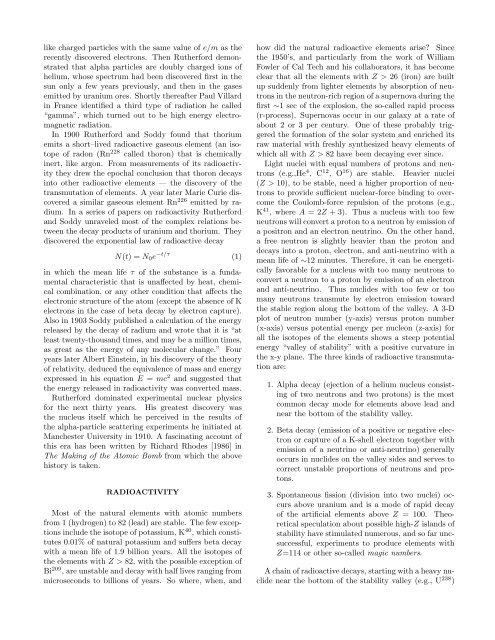The Quantum Mechanics of Alpha Decay
The Quantum Mechanics of Alpha Decay
The Quantum Mechanics of Alpha Decay
You also want an ePaper? Increase the reach of your titles
YUMPU automatically turns print PDFs into web optimized ePapers that Google loves.
like charged particles with the same value <strong>of</strong> e/m as therecently discovered electrons. <strong>The</strong>n Rutherford demonstratedthat alpha particles are doubly charged ions <strong>of</strong>helium, whose spectrum had been discovered first in thesun only a few years previously, and then in the gasesemitted by uranium ores. Shortly thereafter Paul Villardin France identified a third type <strong>of</strong> radiation he called“gamma”, which turned out to be high energy electromagneticradiation.In 1900 Rutherford and Soddy found that thoriumemits a short–lived radioactive gaseous element (an isotope<strong>of</strong> radon (Rn 228 called thoron) that is chemicallyinert, like argon. From measurements <strong>of</strong> its radioactivitythey drew the epochal conclusion that thoron decaysinto other radioactive elements — the discovery <strong>of</strong> thetransmutation <strong>of</strong> elements. A year later Marie Curie discovereda similar gaseous element Rn 226 emitted by radium.In a series <strong>of</strong> papers on radioactivity Rutherfordand Soddy unraveled most <strong>of</strong> the complex relations betweenthe decay products <strong>of</strong> uranium and thorium. <strong>The</strong>ydiscovered the exponential law <strong>of</strong> radioactive decayN(t) = N 0 e −t/τ (1)in which the mean life τ <strong>of</strong> the substance is a fundamentalcharacteristic that is unaffected by heat, chemicalcombination, or any other condition that affects theelectronic structure <strong>of</strong> the atom (except the absence <strong>of</strong> Kelectrons in the case <strong>of</strong> beta decay by electron capture).Also in 1903 Soddy published a calculation <strong>of</strong> the energyreleased by the decay <strong>of</strong> radium and wrote that it is “atleast twenty-thousand times, and may be a million times,as great as the energy <strong>of</strong> any molecular change.” Fouryears later Albert Einstein, in his discovery <strong>of</strong> the theory<strong>of</strong> relativity, deduced the equivalence <strong>of</strong> mass and energyexpressed in his equation E = mc 2 and suggested thatthe energy released in radioactivity was converted mass.Rutherford dominated experimental nuclear physicsfor the next thirty years. His greatest discovery wasthe nucleus itself which he perceived in the results <strong>of</strong>the alpha-particle scattering experiments he initiated atManchester University in 1910. A fascinating account <strong>of</strong>this era has been written by Richard Rhodes [1986] in<strong>The</strong> Making <strong>of</strong> the Atomic Bomb from which the abovehistory is taken.RADIOACTIVITYMost <strong>of</strong> the natural elements with atomic numbersfrom 1 (hydrogen) to 82 (lead) are stable. <strong>The</strong> few exceptionsinclude the isotope <strong>of</strong> potassium, K 40 , which constitutes0.01% <strong>of</strong> natural potassium and suffers beta decaywith a mean life <strong>of</strong> 1.9 billion years. All the isotopes <strong>of</strong>the elements with Z > 82, with the possible exception <strong>of</strong>Bi 209 , are unstable and decay with half lives ranging frommicroseconds to billions <strong>of</strong> years. So where, when, andhow did the natural radioactive elements arise? Sincethe 1950’s, and particularly from the work <strong>of</strong> WilliamFowler <strong>of</strong> Cal Tech and his collaborators, it has becomeclear that all the elements with Z > 26 (iron) are builtup suddenly from lighter elements by absorption <strong>of</strong> neutronsin the neutron-rich region <strong>of</strong> a supernova during thefirst ∼1 sec <strong>of</strong> the explosion, the so-called rapid process(r-process). Supernovas occur in our galaxy at a rate <strong>of</strong>about 2 or 3 per century. One <strong>of</strong> these probably triggeredthe formation <strong>of</strong> the solar system and enriched itsraw material with freshly synthesized heavy elements <strong>of</strong>which all with Z > 82 have been decaying ever since.Light nuclei with equal numbers <strong>of</strong> protons and neutrons(e.g.,He 4 , C 12 , O 16 ) are stable. Heavier nuclei(Z > 10), to be stable, need a higher proportion <strong>of</strong> neutronsto provide sufficient nuclear-force binding to overcomethe Coulomb-force repulsion <strong>of</strong> the protons (e.g.,K 41 , where A = 2Z + 3). Thus a nucleus with too fewneutrons will convert a proton to a neutron by emission <strong>of</strong>a positron and an electron neutrino. On the other hand,a free neutron is slightly heavier than the proton anddecays into a proton, electron, and anti-neutrino with amean life <strong>of</strong> ∼12 minutes. <strong>The</strong>refore, it can be energeticallyfavorable for a nucleus with too many neutrons toconvert a neutron to a proton by emission <strong>of</strong> an electronand anti-neutrino. Thus nuclides with too few or toomany neutrons transmute by electron emission towardthe stable region along the bottom <strong>of</strong> the valley. A 3-Dplot <strong>of</strong> neutron number (y-axis) versus proton number(x-axis) versus potential energy per nucleon (z-axis) forall the isotopes <strong>of</strong> the elements shows a steep potentialenergy “valley <strong>of</strong> stability” with a positive curvature inthe x-y plane. <strong>The</strong> three kinds <strong>of</strong> radioactive transmutationare:1. <strong>Alpha</strong> decay (ejection <strong>of</strong> a helium nucleus consisting<strong>of</strong> two neutrons and two protons) is the mostcommon decay mode for elements above lead andnear the bottom <strong>of</strong> the stability valley.2. Beta decay (emission <strong>of</strong> a positive or negative electronor capture <strong>of</strong> a K-shell electron together withemission <strong>of</strong> a neutrino or anti-neutrino) generallyoccurs in nuclides on the valley sides and serves tocorrect unstable proportions <strong>of</strong> neutrons and protons.3. Spontaneous fission (division into two nuclei) occursabove uranium and is a mode <strong>of</strong> rapid decay<strong>of</strong> the artificial elements above Z = 100. <strong>The</strong>oreticalspeculation about possible high-Z islands <strong>of</strong>stability have stimulated numerous, and so far uncsuccessful,experiments to produce elements withZ=114 or other so-called magic numbers.A chain <strong>of</strong> radioactive decays, starting with a heavy nuclidenear the bottom <strong>of</strong> the stability valley (e.g., U 238 )















